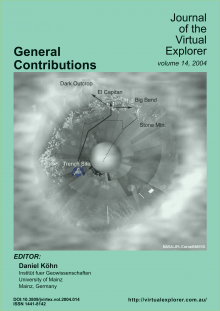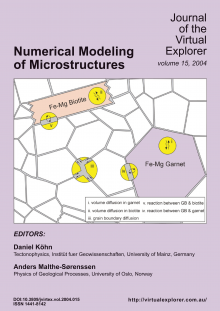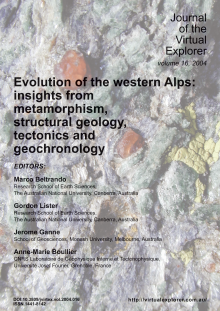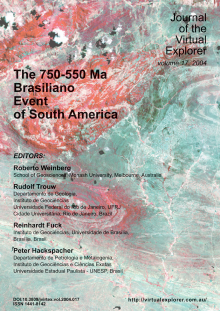- Home
- Journal
- 2017 -- 50, 51
- 2016 -- 49, 50
- 2015 -- 48
- 2014 -- 46, 47
- 2013 -- 44, 45
- 2012 -- 40, 41, 42, 43
- 2011 -- 37, 38, 39
- 2010 -- 35, 36
- 2009 -- 31, 32, 33, 34
- 2008 -- 28, 29, 30
- 2007 -- 25, 26, 27
- 2006 -- 21, 22, 23, 24
- 2005 -- 18, 19, 20
- 2004 -- 14, 15, 16, 17
- 2003 -- 10, 11, 12, 13
- 2002 -- 6, 7, 8, 9
- 2001 -- 3, 4, 5
- 2000 -- 1, 2
- Editorial Board
- Policies
2004 Issues
Edited by:
General contributions in 2004 included sub-rotation of a plate, and structural mapping on Mars.
Edited by:
This volume focused on numerical aspects of the quantitative modelling of microstructure development. simulation of disequilibrium structures in solid-melt systems during grain-growth, donation, kink-bands, dissolution of stressed solids, an Elle model for garnet and biotite exchange, and a simulation of the rotation of porphyroblasts.
Edited by: Gordon S. Lister
This volume includes several original contributions focussed on the tectonic evolution of the Western Alps, including brittle deformation between internal gneiss domes, a Palaeo Ocean Floor in the Subducted Tethys, a serpentinite subduction channel the Monviso ophiolite massif, subduction of the Alpine crust in the Sesia-Lanzo zone, a new eclogitic unit in the Cottian Alps,
structural evolution versus rock chemistry during eclogization, post-nappe brittle tectonics, and implications of a 330 Ma-old magnesio-potassic magmatic suite.
Edited by:
Several NeoProterozoic orogenic belts occur in southeast and south Brazil: the Araçuaí, Ribeira, Southern Brasília, Dom Feliciano and São Gabriel. They developed during the Brasiliano-Pan-African Orogeny that resulted in the amalgamation of Gondwana.
The Neoproterozoic orogenic evolution started with the consumption of the Goianides and Adamastor oceans, located at the western and southeastern sides of the São Francisco paleocontinent. Subduction generated magmatic arc suites and was followed by arc-continent and continent-continent collisions. The collisional episodes were diachronous, the oldest are recorded in the SW of the region considered, in the Apiaí Terrane (ca. 790 Ma) and in the São Gabriel Orogen (ca. 700 Ma).
They were followed by collisions in the southern Brasília Orogen, in the Apiaí Terrane (ca. 630-610 Ma) and in the Dom Feliciano Orogen (ca. 600 Ma). Then collision occurred in the Ribeira and Araçuaí Orogens in the period between 580 Ma and 520 Ma. Finally, the extensional collapse of the orogens took place from the Cambrian to Ordovician (ca. 520-480 Ma).



